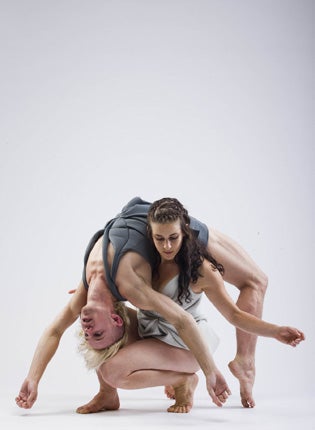In the Spirit of Diaghilev, Sadler's Wells, London

Sadler's Wells salutes Diaghilev's Ballets Russes, the most innovative ballet troupe of the 20th century, by commissioning new works from four big name choreographers. As in Diaghilev's regime, the stress is on collaboration. It throws up everything from the dreamy to the fatuous.
Russell Maliphant's Afterlight, danced to Satie piano music, is the finest thing here, a solo inspired by Nijinsky's geometric drawings. Daniel Proietto spins in the spotlight, a pool of light turning under his feet. His spins so smoothly that he seems to be on a turntable, whirling in dappled, circular patterns. When he crosses the stage, light blooms under his feet, spreading across the stage like cloud shadows, or ink in water. It's Maliphant's best work in ages.
Sidi Larbi Cherkaoui's Faun revisits the Debussy/Nijinsky ballet, with extra music by Nitin Sawhney. James O'Hara's faun, dressed in a knotted silk tunic, curls into intricate yoga positions. The movement is animalist and smoothly controlled. When Daisy Phillips appears, to new music, it suggests a change of perspective: his view, then hers. They twist around each other, keeping their feet together as if playing at being shadows. It's an atmospheric work, helped by a backdrop of forest scenery with changing light.
Wayne McGregor's Dyad 1909 was inspired by Shackleton's expedition to the South Pole, in the same year that the Ballets Russes was created. The curtain goes up on a Shackleton figure, wrapped in polar furs, looking at a group of dancers in glittering face makeup. An exhausted explorer seeing visions? Ice fairies at the South Pole?
Whatever the idea is, it vanishes pretty quickly. The figure collapses, leaving the dancers to do generic McGregor choreography. His hallmarks are all there – the extreme extensions, the arch-back pose with ribs and buttocks thrust out. They're assembled, though, with little momentum or apparent care for the stage picture.
Javier De Frutos's Eternal Damnation to Sancho and Sanchez tries very hard to be shocking. It recognises the provocative side of Diaghilev, but did it have to be so boring? A deformed Pope gropes everyone on stage, muses wear pregnancy padding, the cast shriek and swear over Ravel's La Valse. There's some energy in Katrina Lindsay's mural, a cartoonish compilation of Michelangelo nudes, but the rest grinds tiresomely on.
Join our commenting forum
Join thought-provoking conversations, follow other Independent readers and see their replies
Comments